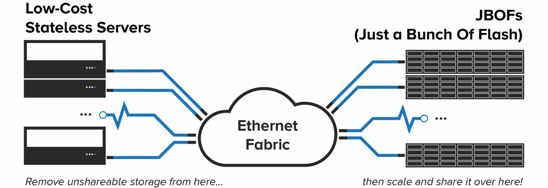Kazan Networks Adds RDMA Over Converged Ethernet Support to NVMe Over Fabrics Solution
Enables disaggregation of compute and storage without sacrificing performance.
This is a Press Release edited by StorageNewsletter.com on November 19, 2015 at 2:45 pmKazan Networks Corporation announced that they have successfully demonstrated RDMA over Converged Ethernet (RoCE) traffic within their NVMe over Fabrics solution, making them the first company to implement both RDMA protocols in a single solution.
NVMe over Fabrics enables disaggregation of compute and storage without sacrificing performance.
In August, Kazan Networks showed a prototype running iWARP at the Intel Developers Forum in San Francisco, CA. With this latest enhancement, the company’s ultra-low latency controller can support simultaneous RoCE and iWARP traffic. Implemented to the NVMe over Fabrics standard under development, the company enables any existing NVMe device to be remotely connected via an Ethernet fabric.
“Our customers have made it very clear that they desire to support both Ethernet RDMA protocols, and we’re pleased to be able to deliver that functionality to them,” said Joe Steinmetz, CEO, Kazan Networks. “Support for both protocols means that customers don’t have to give up any market opportunities.“
NVMe over Fabrics defines a new paradigm in high-performance flash connectivity with the potetial to change how solid state storage is configured, accessed, and managed within the datacenter. By centralizing and pooling flash, compute and storage infrastructure can be deployed and scaled independently, offering new levels of flexibility and lowering TCO.
With its low-latency solution, the company demonstrates that accessing flash remotely does not need to come at the expense of performance. By adding less than 500 nanoseconds of latency through its ASIC, the company expects to enable high performance solution.
Fully accelerated, all-hardware implementation of the data paths through its ASIC represents a approach to an NVMe over Fabrics solution. By removing the need to run firmware on an embedded microprocessor, latencies through the ASIC’s data paths are now measured in fractions of a microsecond, far faster than can be achieved by other SoC approaches.
Read also:
Start-Up Kazan Networks Emerged From Stealth Mode
Demonstrating NVMe over Fabrics solution for flash connectivity
This is a Press Release edited by StorageNewsletter.com on 2015.08.24













 Subscribe to our free daily newsletter
Subscribe to our free daily newsletter
